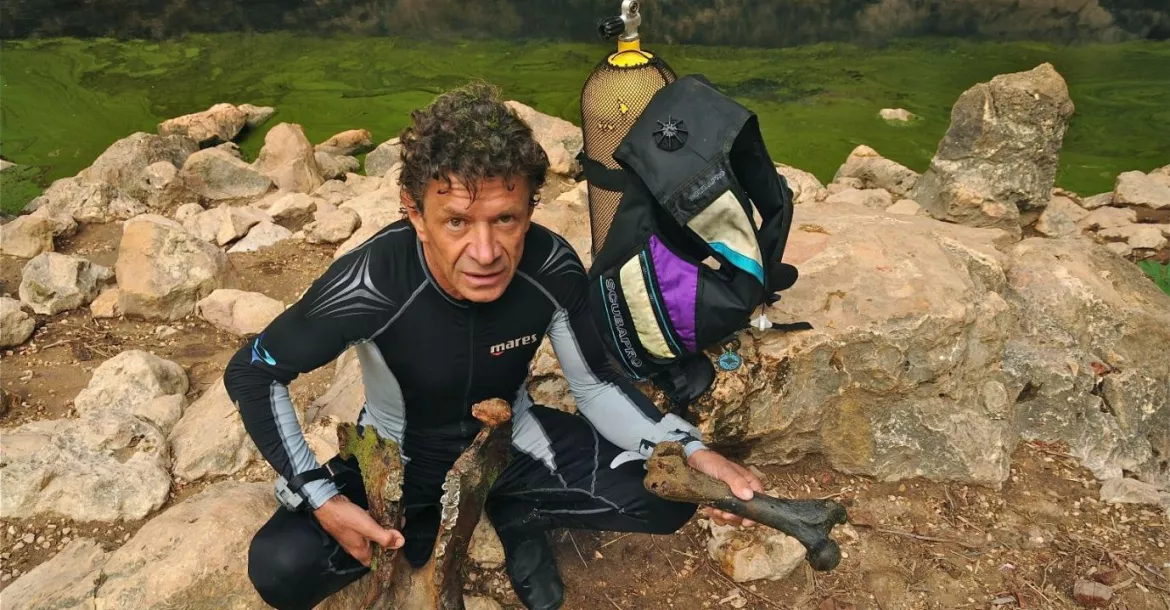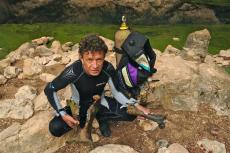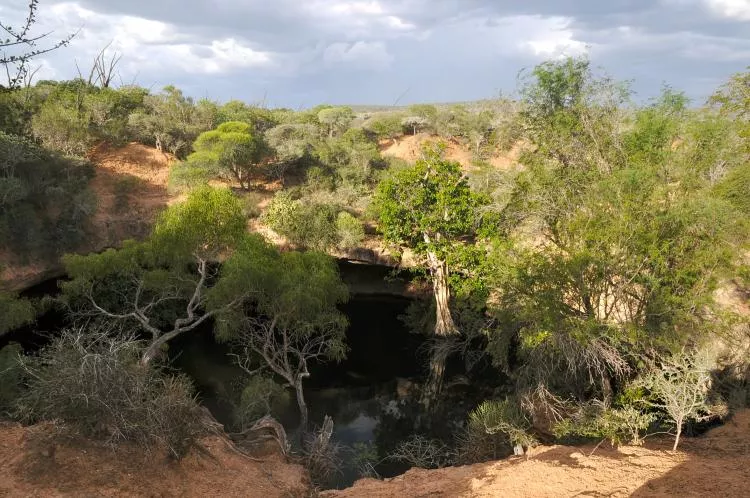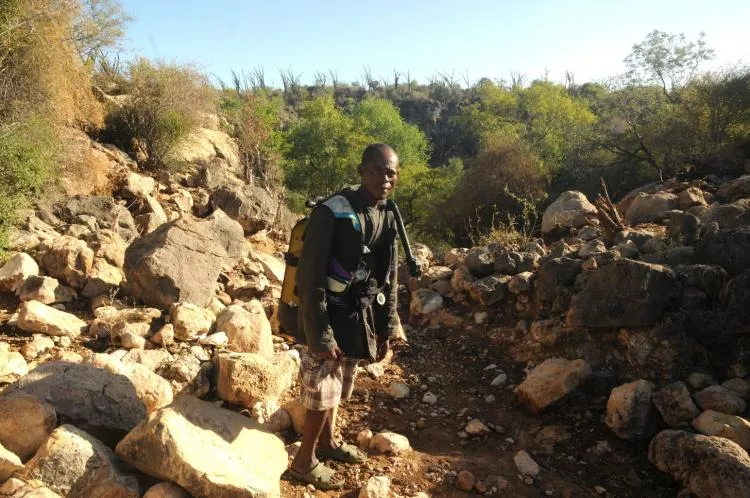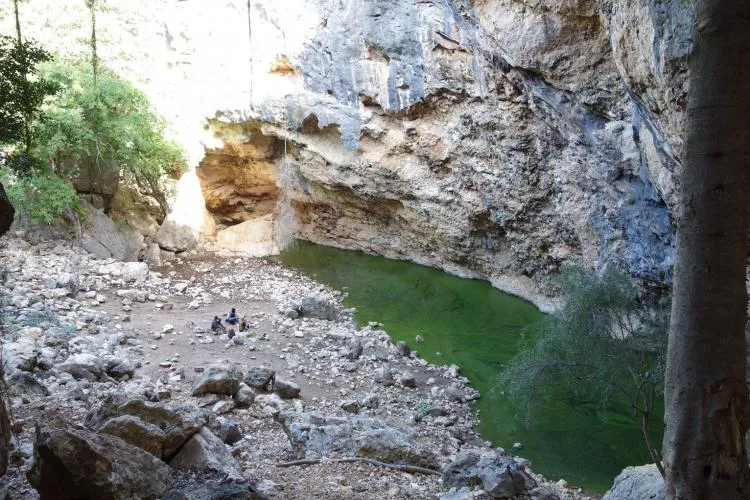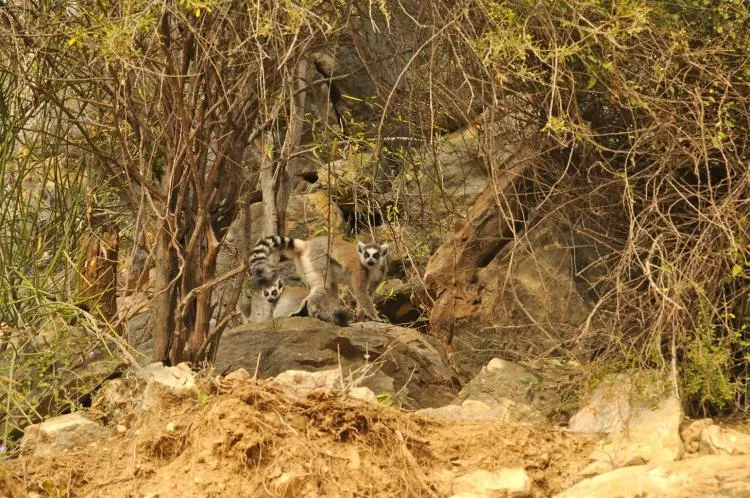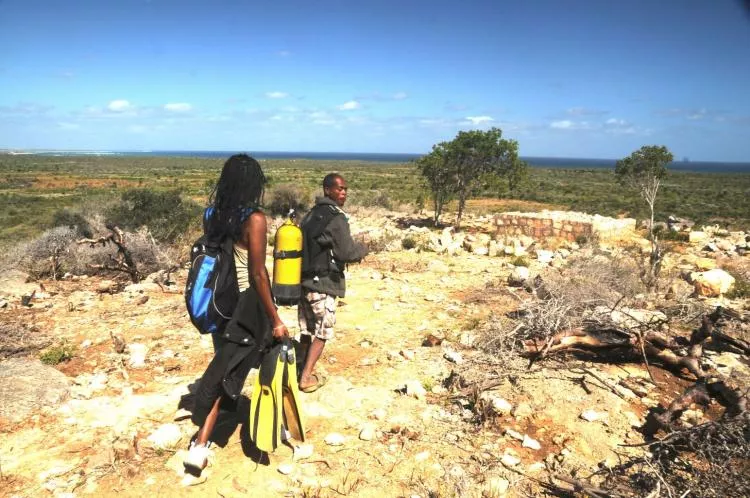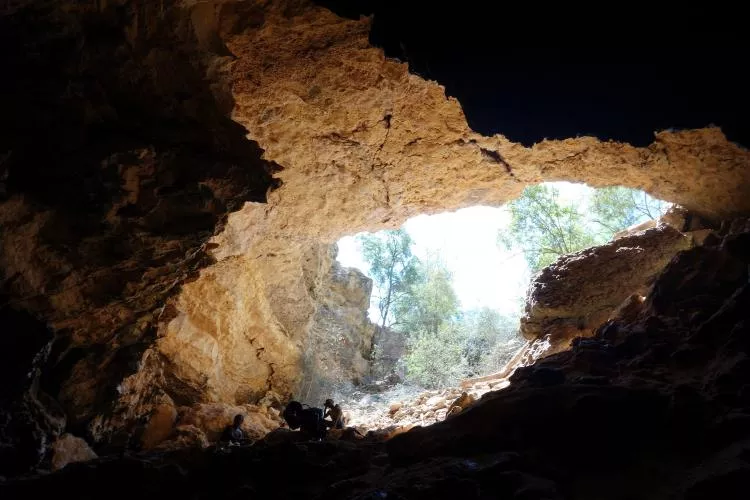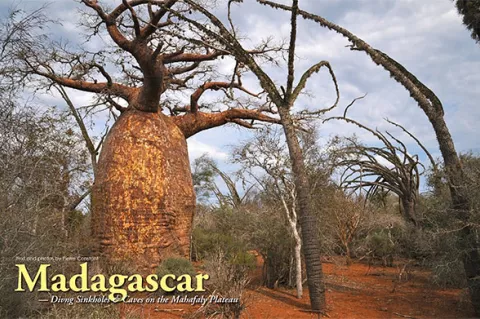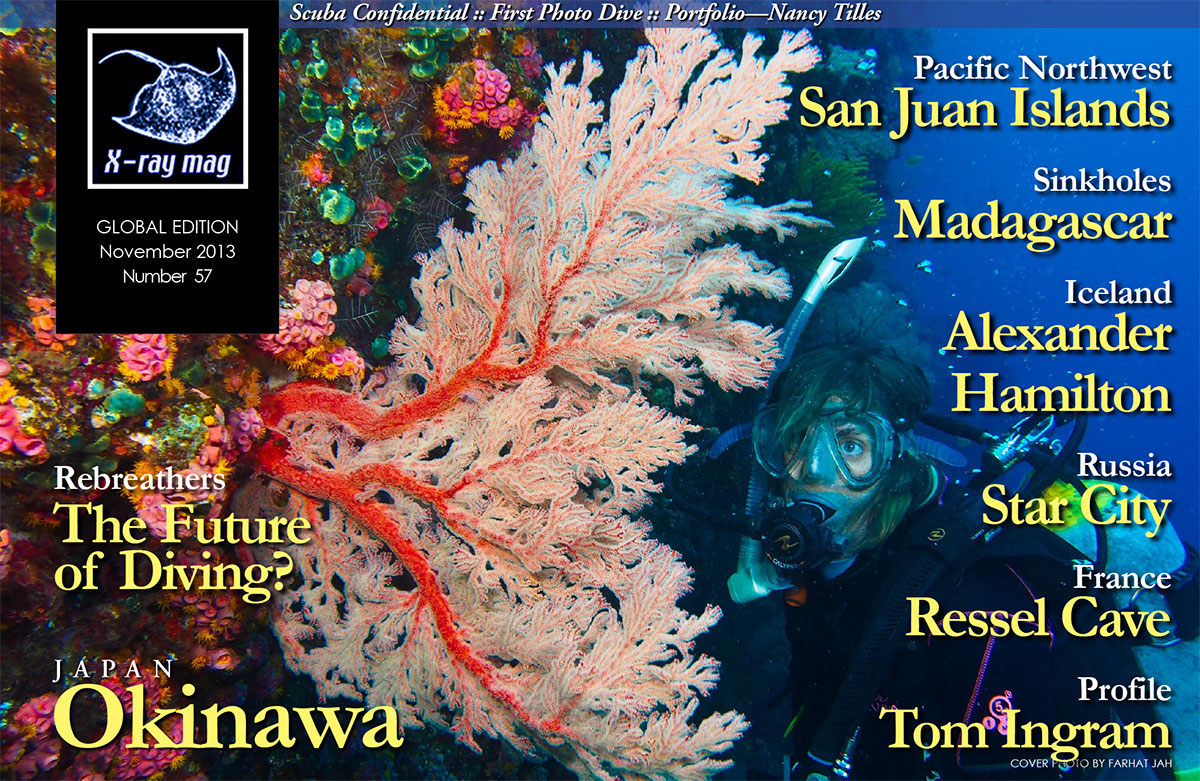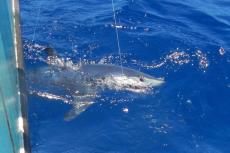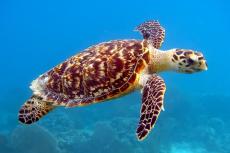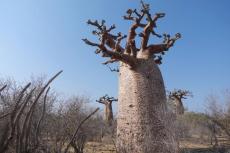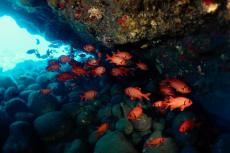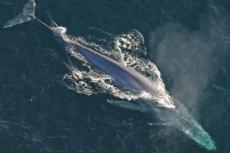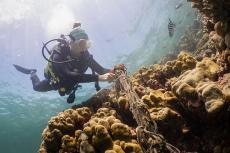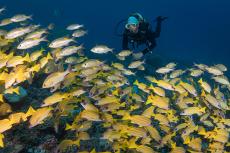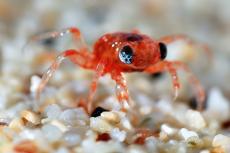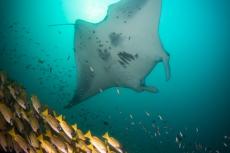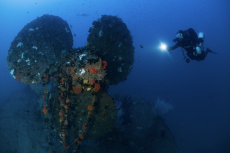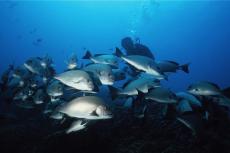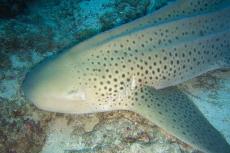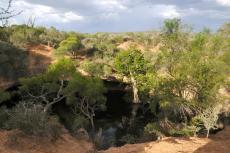Stretching west and north of the Isalo Ranges, the Mahafaly Plateau runs like a dragon’s tongue to the very tip of Madagascar’s southwest coast. This is a remote country in the Great South, where numerous historical shipwrecks have lain below the waves since the 16th century.
Contributed by
The Mahafaly Plateau has been affected by post-Eocene tectonic movements with a northwest-southeast distension, which tops an older tectonic event on the underlying substrate. Seismic activity is a common occurrence there. The karst process is intense in the lower Eocene with very deep caving systems, whereas in the mid-Eocene, sinkholes are only visible.
A number of these sinkholes, or avens as they are locally known in the French language, were brought to light by aerial photography taken by the French (Battestini 1964, IGN 1966). Looking like cauldrons, these collapsed sinkholes, round or oval in shape, measure anything from a few dozen metres up to 500 metres in diameter, with depths ranging from 40m to over 100m. They are natural wonders that make one hold one’s breath for a minute.
Tsimanampetsotse National Park
Crossing the Bay of St Augustine on a flat sea, our speedboat made a beeline to Anakao, a Vezo fishermen village under the sun. The white beach was fringed by a turquoise green lagoon, cradled between the historic Nosy Ve Island and the mainland. It looked like a picture perfect postcard, with local outrigger canoes sailing back and forth on their fishing trips—an impression of paradise rediscovered.
A coastal track follows the west coast 56km to Efoetsy—gateway to Tsimanampetsotse National Park, whose exquisite Malagasy name means, “there are no dolphins”. A nature reserve created in 1928 during the French colonial administration, the park is comprised of a huge lake—15km long and 2km wide—equaling a surface of 3,750 hectares, home to two species of flamingoes. The natural reservoir is fed by the springs coming out of the cliff, and by the avens as well.
A few caves and spectacular sinkholes are found in the park, home to giant banyans. Amazing roots climb down into the holes in search of water.
At Mitoho Cave, a small lake hosts some albino Eleotrid blind fish—pink and white—of the Typhleotris genus. These small creatures timidly skim the surface.
The hour-and-a-half loop circuit of Tsiamaso (meaning “without eyes” and related to spirits) allows access to the cave of Andranolovy where a huge five-stemmed Madagascar palm tree (Pachypodium geayi) guards the entrance.
A stone’s throw away, one comes to the aven of Vintany where a curtain of roots of the aviavy tree spill down like a waterfall to the existing water table. A bit further along, the lone baobab (Andansonia rubrostipa), or “grand mère”, puffed up and covered with open warts, stands still like a matriarch lost in time.
The dirt road continues south into white sand, across an arid, sun-parched countryside. The spiny bush is a landscape composed of almond green silver thicket (Euphorbia stenodacla), with thorny branches, and rather exotic octopus trees of the Didieracae genus, which look like candelabra cactus. However, their trunks are made of wood, covered with spines and also tiny leaves.
Itampolo
The town of Itampolo, a name meaning “ten cameleons”, is another two hours further. Beyond the picturesque fishing village and the idyllic beach on the waterfront, the attraction here lays in the existence of two sinkholes worth visiting.
Avintany, in the lowlands, is an aven ten metres deep, full of water and accessible only through the roots of an aviavy tree. The clear water of the lake is enticing. The cream coloured limestone cliff is quite hard, present with flintstones, sandstone and sedimentary tuffs.
A second aven named Androinpany is found 5km inland, on the top of the Mahafaly Plateau, hidden in a forest of spiny Alluaudia, a species of octopus tree. Androinpany is a circular pit, 15 metres across, with sheer walls that plunge down to 66 metres in one drop. Impressive enough, it is inhabited by a couple of maki lemurs, which live in cracks near the entrance of the sinkhole. The site is also home to rather inquisitive black vasa parrots and a couple of kestrel falcons.
“Some years ago, two Portuguese men came here with ropes and climbed down to the bottom,” said our guide, Dongary. I could make out a pile of debris at the centre of the sinkhole, with a ring of water indicating a possible cave underground.
Intrigued by these fascinating sinkholes, I returned to Itampolo four times in the course of two years.
Avintany sinkhole
At Avintany, which is 34m by 22m across, I lowered a scuba tank and dive equipment with a rope and a camera in a bucket, then climbed down the roots of the aviavy tree like a lemur ‘holding onto dear life’. The initial snorkel around the pit indicated a depth of 10m around a central mound crested with green vegetation—a mini forest of stems with whiskers.
Prehistoric looking, brownish copper blindfish, Typhleotris mararybe, (identified as a new species in December 2012) with a duck beak, swam about under the overhangs in the shallows, together with what looked like an aquatic mantis (water scorpion). Streams of bubbles rose from the sedimentary floor in places, proof of ancient volcanic activity.
Subsequent scuba dives revealed caves in the north, south and east ends. The larger, most accessible being the former one, which extended to 80m over a lunar landscape of silt ridges, down to a depth of 25m.
Bumping into a solid wall at the far end, I noticed a deeper passage that sank down to 30m, in a sort of bottleneck crowned with white sediments—a ‘no-no’ for a solo diver to attempt. At the top of the passage, dug into the silt, I gazed upon some blackened bones—vertebras of what could be an elephant bird (Aepyornis) or a crocodile tail.
For the Malagasy people, these avens are fady, which means taboo or sacred in the local tongue. Locals are afraid of them, for they believe dreadful spirits inhabit them. Others come here to practice rituals—including the sacrifice of a black rooster or a goat—and bring offerings, such as a bottle of rum, cigarettes or money. “Women pray for fecundity, in the hope to have a child,” I was told.
Binabe Cave
The sun is at its apex when I left Tulear in a wrecked taxi, held together only by the grace of the Holy Spirit. Shortly, we sighted Sarudrano Spring. One hour later, a white signboard indicated with an arrow, “Binabe, grotte sacrée”—a sacred cave it is.
This is where, in search of the place a few months ago, I had climbed on top of the Mahafaly Plateau and almost gotten lost. An old local guide popped out of the blue, as if by enchantment, from the nearby village. “Five thousand ariary for the two of you,” he demanded at once.
Tank on my back, camera bag strapped across the shoulder, Nikonos V at arm’s length and a dive bag on the other shoulder, I followed in his footsteps for a ten-minute walk into the bush, expedition member, Christina, in tow with my fins and knapsack. An awesome sight, the cliff appeared 20 metres high, looming forward and reflecting a yellowish white light. I was already sweating profusely.
The trail snaked its way down a rubble slope with scattered rocks, into the shade of a hole. The few sunbeams striking through a pool of freshwater created a beautiful jewel blue aura. Nevertheless, I was filled with a bit of fear at the thought of venturing into the dark unknown.
Moving through the water stirred up black sediment right away, which was, in fact, bat guano. Great caution would have to be used to avoid disturbing the visibility.
Under the surface, some small dark brown blind fish moved about shyly. Some time later, I noticed a bigger fish, 15cm to 20cm long, with two dorsal fins and a rounded caudal fin with a pointed tip, which looked just like a flame at the back of a rocket. My attempt to approach it was made in vain, as it fled in a flash! This one was certainly not blind.
Sinking in the depths, I observed tiny crabs—1cm long—in the water column, then large shrimps 5cm to 10cm long, on the guano slope, quite intrigued by my other worldly appearance.
The bottom plummeted gradually east, opening into a vast chamber about 20 metres wide. I came to a dead end at a depth of 33 metres. The wall was soft and crumbled easily. The cave floor was like a dark desert, mottled like salt and pepper, and crisscrossed by tiny tracks of mysterious critters. Isolated specimens of blind fish cruised by at random over the guano landscape.
Making my way up along the north side, I gazed upon what looked like a blackened fossil cast into the wall. I took a photo for memory. The dive into Binabe Cave lasted 30 minutes, and the water temperature was 26°C. At all times, I could see the light from the surface.
A few months later, I returned for another exploratory dive, and found—at a depth of 25 metres—the femur of an extinct species of dwarf hippopotamus, Hippopotamus lemerlei, from southwest Madagascar. Identified as such by JR Boisserie, it was one of the three ancient species of Malagasy hippo that have disappeared over a thousand years ago.
I brought the hippo femur I discovered to a research lab at the Museum of Natural History in Paris and was fortunate enough to meet Dr Antoine Zazzo and his collegue Olivier Tombret, who agreed to do carbon-dating analysis of the bone. It was found to be approximately 1,394 years old, dating back to the 7th century, between 595 AD and 677 AD.
Vintany sinkhole
A few days later, I returned to Tsimanampetsotse National Park in search of new avens, or cenotes. On the Andranalamalaïka circuit, Malagasy guide Nicolas took me to the collapsed sinkhole of Andrianamaniloky. There, at the bottom of a treacherous slope of slippery boulders, a pool of clear water hid in the darkness. A number of pink and white blindfish, Typhleotris madagascariensis, were swimming upside down at the surface, as if trying to breathe: “It’s impossible to dive here—the site is forbidden.”
A stone’s throw away was the aven of Filomeni, which was a narrow pit, maybe 2m in diameter, where roots of an aviavy tree plunged down vertically to an unknown depth. Penetration was risky and impossible without the proper gear. A fortiori—“The site is inhabited by spirits,” explained Nicolas, pale as the specter of death.
The morning after, I was back with Ryan, an Australian diver, and his mate, Anthony, from a dive centre in Anakao. The aven of Vintany was explored by the latter two in May 2012, 16 years after Jean Michel Cousteau went in with his team.
The park newly grants permission to dive Vintany, following an agreement with Le Relais d’Ambola Hotel in Ambola. The site is a mere ten-minute walk from the Mitoho car park, on the top of the Mahafaly Plateau. Visually appealing, the sinkhole is ten metres deep. Ropes and harness are recommended to climb down into it, as well as to lower tanks and gear.
Nonetheless, with helmet on for extra safety, I made use of a root of a banyan tree to ease my way down along the cliff side. Once into the pit, I could only marvel at the waterfall of roots, cascading down like a curtain of white stems. Quite a sight, indeed!
White and pink blind fish were skimming the surface. I had a feeling of déjà vu, as the floor sediment was again bat guano, easily stirred up. Anthony led me underwater, above a field of rocks and boulders resulting from the collapse of the roof.
For a while, he seemed to be searching for something. Then suddenly, he pointed towards a collection of bones. In a stupor, I stared at the skull and jaws of a crocodile, a brownish golden colour, with an easily recognizable tooth. Dreadful. The specimen was probably 1.5 metres long.
A short distance away, I discovered another jaw of a younger specimen, with all its teeth. A thrill ran up my spine at the thought that 1,000 years ago, or even 10,000 years ago, the site was a crocodile haven. By all means, there would have been fish as well, otherwise how could the monsters have survived?
Further down the slope, small lemur skulls lay here and there, once prey of the reptiles. The most visually striking piece was an almost complete skeleton of a crocodile with dorsal spine intact. The vertebra rings were just massive.
Majestically, the wonders of the cave revealed themselves at depth, as the cavern descended in various balconies. Clusters of stalactites came down from the roof of the cave, with truncated stalagmites underneath—evidence that the aven was once a dry cave for at least 20,000 years, judging by the fact that some stalagmites were two metres tall, not to mention the amount of bat guano present. Other broken stalagmites attested to the occurrence of ancient earthquakes. It was, I thought, “Elementary, my dear Watson!”
At a depth of 28 metres, shawls of calcite gracefully decorated the walls at a height of two to three meters. The gin clear visibility was a definite plus in appreciating these geological wonders, preserved in their timeless shroud.
The progressive return to the surface was a vision of fairyland. The wide angle panorama of the curtain of roots, outlined against the backlight, was superb. One came out of the water with a sensation of bliss. Vintany was the magical aven—a dive of 55 minutes, at a bath temperature of 29°C. Unbelievable, but true!
Upon exiting the sinkhole, I noticed a family of ring-tailed lemurs, or “makis”, frolicking joyfully in the foliage of the banyan tree. Curious of the day visitors, they fed actively on the capsules of the giant ficus. The lemurs gave me roguish glances and hopped swiftly from branch to branch, as if everything was going for the better in the best of worlds. I thought to myself, “By Jove! When the crocs are gone, the makis dance.”
After my discovery of the femur of a dwarf hippopotamus at Binabe Cave in November 2012, I was keen to return to the area again and explore some more.
Andramanoatse
One sunny morning, on my way to Itampolo in our driver José’s 4x4, we stopped at various villages in the heart of the bush, as I was trying to locate a new sinkhole far inland. The driver was helpful in translating my questions to a local man, who seemed to have a clue to what I was talking about.
“Yes, yes, big hole… clear water, good to drink, no cattle access,” he said. That sounded good. Although it was a bit far and he didn’t know how long we’d have to walk on top of the Mahafaly Plateau, he was willing to guide me and help carry the scuba tank, for a reasonable fee.
We made an appointment two days later, early in the morning, because I guess the sun would be a killer. I found him, as promised, sitting under a tree, in the center of the village of Kuristy, a cluster of wooden huts that looked like a shanty town.
We were off to Andrama-noatse aven. The guide stoically carried the 15-litre steel tank attached to the BCD on his back. Christina followed with the fins and some water, and I took the rest of the dive equipment in a yellow mesh bag, in addition to a knapsack with the camera. Fifteen minutes later, we climbed up to the Mahafaly Plateau.
The somewhat clear trail divided into other trails across forests of Alluaudia, and Didieracea—octopus trees with the weirdest shapes. Isolated bottle baobabs dotted the landscape like giants. Blue couas—endemic birds with long tails—hopped across the trail once in a while, adding a touch of life to this apparent no man’s land.
One hour had elapsed when we started descending into a valley, stepping over slabs of hard white limestone. Suddenly, the guide turned around stretching his arms with a smile—we were here.
The collapsed sinkhole was about 100 metres in diameter. Facing east, the cliff was 50m high and imposing. Climbing down the slope of rubble and boulders among trees and shrubs, we came to a small lake covered by a film of green algae at the base of the massive wall broken by some slanting fractures.
The place looked definitively prehistoric. Big banyan-like aviavy trees with extensive roots bordered the sinkhole inside the pit. The number of dungs and other droppings scattered around left no doubt that cattle and goats came to drink here, not only humans!
After I threw a stone into the pool, I noticed clear water below the film, and that was encouraging, at least. Venturing around the sides and on the top of the aven for photographic angles, I spotted some maki lemurs and black vasa parrots in the area.
After getting ready for the dive, I entered the water cautiously. The first hole on the left plunged deep under the rocky overhang. The silt on the slope was very thick, fine and easily stirred up, troubling visibility immediately. I secured a tie-off to the roof of the cave, and I reeled my way in, down to 20 metres, soon to find myself in a silt storm.
“It doesn’t make sense to continue into this madness alone,” I thought to myself. The passage was too narrow. I turned around and tried the second hole to the left, as I exited. Funnel-like in shape, it was the same story in the second hole, and I gave up after a while.
At the third hole, I understood that I would have no luck there either, silting out the same as the last two. But just as I made my way back to the surface through a cloud of pastel green yellowish silt, I came to what looked like dead branches sticking eerily out of the mud.
Not that I had ever come across that sort of curiosity before, but I recognized at once the forking truncated end of the jaw with four tooth holes in the middle and the two prominent outer holes of the tusks, with one still in place, albeit broken—it was the lower jaw of a dwarf hippopotamus. There was also a femur blackened with age.
Although the water temperature was a comfortable 27°C, after 22 minutes diving at 21m, I started shivering in my Lycra suit. A few local people suddenly materialized out of thin air, coming down into the sinkhole to collect some water for their journey onward. They looked at us with inquisitive glances, and I decided to move on swiftly.
“I shall be back for some more explorations elsewhere next time!” I told the guide, as we shook hands heartily. We left in a cloud of dust, bound for Ambola where we would spend the night. On the way home, I was already planning another exploratory dive at the isolated Andrianamaniloka (sinkhole) cave in Tsimanampetsotse National Park. ■
Pierre Constant is an author, photographer, dive master, naturalist consultant and expedition organizer based in the Galapagos Islands. Constant will organise a trip to southern Madagascar in May and September next year. For more information, visit: Calaolife.com and Scubadragongalapagos.com
Published in
- Log in to post comments

